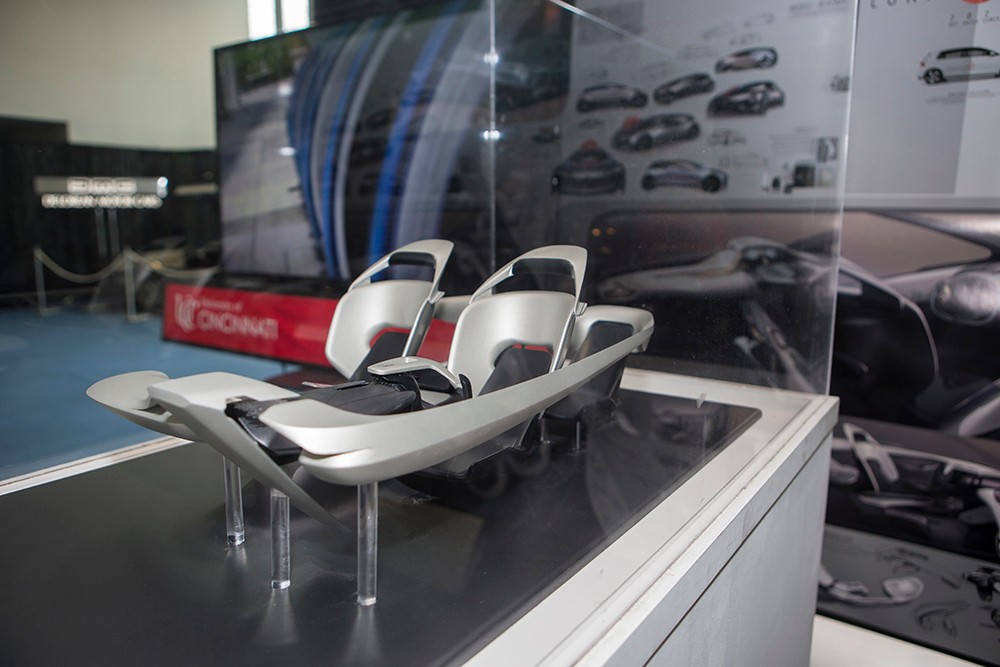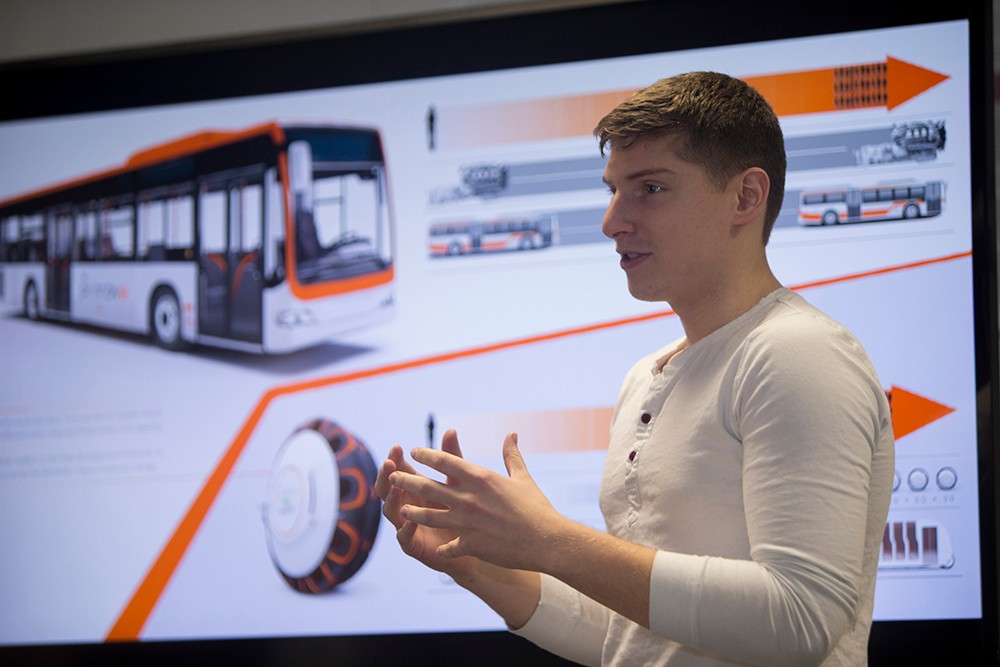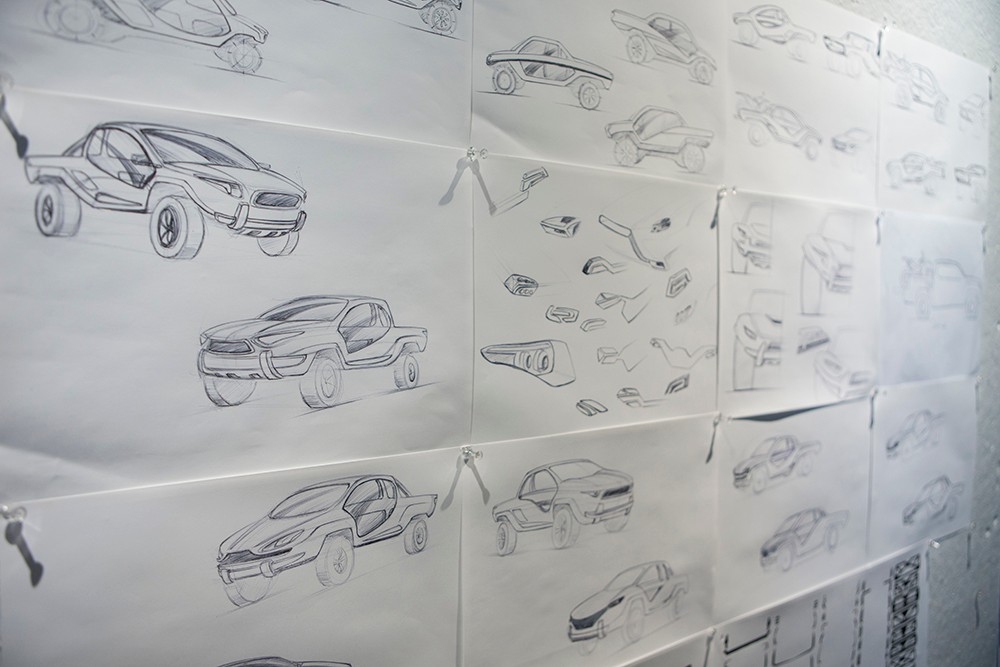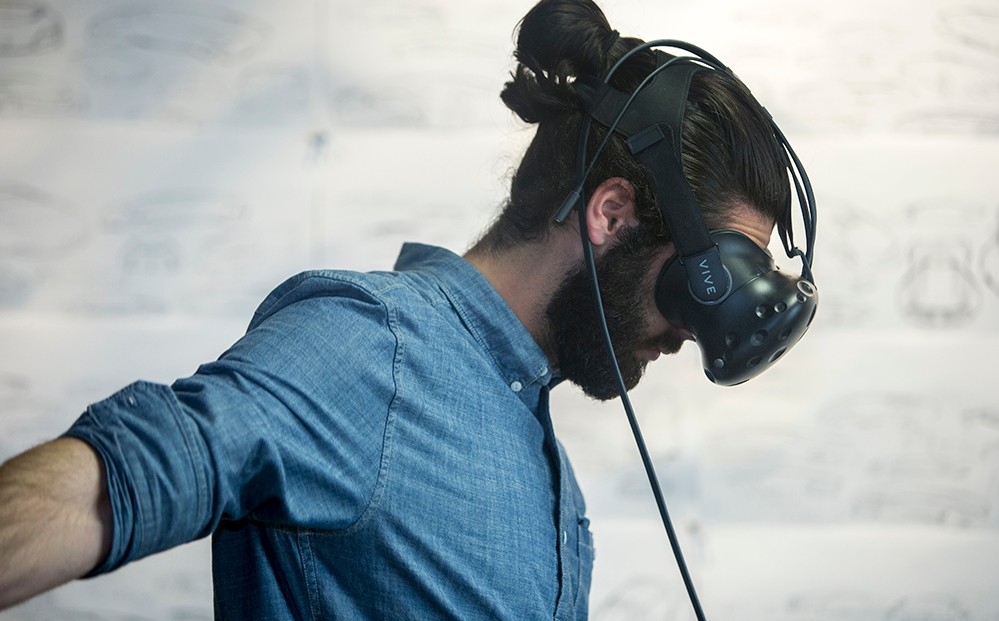DAAP transportation design student Joseph Boniface uses a virtual reality headset to help visualize his car concept.
Photo/Andrew Higley/UC Creative Services
Autopilot
With self-driving vehicles on the horizon, DAAP industrial design students reimagine mobility from the inside out
by Jac Kern
513-556-1823
April 20, 2017
Imagine never having to drive to work again. You still travel by car, maybe by requesting a ride, enter your destination and set off. You could spend your morning commute answering emails, enjoying breakfast or maybe getting an extra 20 minutes of rest. While traffic may be inevitable, you won’t have to worry about what’s happening on the road. And there’s no awkward small talk to make with the ride-sharing stranger behind the wheel. This car drives itself.
Forget your work commute — driving altogether becomes a thing of the past.
For some this may sound like a futuristic science fiction fantasy, but for students at the University of Cincinnati’s Myron E. Ullman, Jr. School of Design in the College of Design, Architecture, Art, and Planning (DAAP), it’s a topic they’re researching and developing today. Between transportation design studios, internships, co-op work and even a showcase at this year’s Cincinnati Auto Expo, autonomous vehicles are a major point of interest.
Autonomous vehicles, or self-driving cars, are being tested today by Tesla, Google and other companies. Ford Motor Co.’s goal is to have its autonomous model ready by 2021. Meanwhile, several semi-autonomous models are already on the road. Any car that parallel parks on its own or auto-brakes is a step on the path to a fully autonomous vehicle. And transportation design students in DAAP’s industrial design program — ranked No. 2 in the country — believe that final destination is closer than you may think.
“I think, realistically, you’ll see highway autonomy happening within five to 10 years, easily,” says student Cameron Bresn, a graduating senior from Lake Zurich, Illinois, who worked for Tesla on one of his four co-ops and is a 2017 Cooperative Education Achievement Award winner. Implementing autonomous technology for city driving, where factors like cyclists and pedestrians come into play, could happen after that.

Professor Islas-Muñoz describes students' futuristic car concepts at the Cincinnati Auto Expo. Photo/Andrew Higley/UC Creative Services
The technology is already available today, but more testing is required before full autonomy will become mainstream. “They could do it now, it’s just a matter of making sure that it truly is safe and getting the public to be accepting of it,” Bresn says. “Because it’s a scary thing, to get into a car that drives itself if you’ve never seen it before.”
Shared mobility
The rise of ride-sharing via apps like Lyft and Uber has already introduced users to the idea of on-demand use of cars that don’t belong to them. Transportation design students see this trend of shared mobility continuing into the autonomous age.
“We think that ride-sharing is going to be the future,” says DAAP student Joseph Boniface, a graduating senior from Youngstown, Ohio. “That’s going to be how we make autonomous accessible to the consumer.”
In 2016, Boniface took a studio sponsored by General Motors Co. that focused on autonomous vehicles. He worked on a group project that explored the idea that in a near-future New York City, car ownership — now around 50 percent — dropped to zero. The project’s result was a shared mobility system with three different types of autonomous vehicles based on the user’s needs.
The hypothetical users could select the appropriate car based on whether they were, for example, planning a business meeting, hauling furniture or taking a date out to dinner. When the trip is complete, the car would make its way to the next user.
“Once you have an autonomous city, vehicles can all function within centimeters of each other,” Boniface says. “And once you do that, you suddenly eliminate traffic. There aren’t any vehicles being parked on the side of the road because they’re all in circulation, picking people up or getting cleaned.”

Student Cameron Bresn's interior model for an autonomous vehicle features movable seats. Photo/Andrew Higley/UC Creative Services

Bresn presents on an autonomous vehicle concept. Photo/Andrew Higley/UC Creative Services
Inside out
For transportation designers, a major question is how these technological changes will alter the look and feel of a vehicle.
When you think of a car’s design and visual appeal, it’s natural to only consider the exterior of the vehicle. But when autonomous capabilities turn cars into mobile offices, meeting spaces and entertainment hubs, the design focus shifts to the interior.
“The reason why car interiors and autonomous vehicles are tied together is because today, the car is something you may buy because of the exterior and it being a sculpture that is awesome to behold,” explains assistant professor Juan Antonio Islas-Muñoz, M (DAAP) ’13. Originally from San Luis Potosí, Mexico, he has taught the transportation design studio since 2015.
“In the future, it’s very likely that you’re not going to buy a car. You’re going to want to experience being in the car.”
When a driver is taken out of the equation, the car’s interior is no longer limited to rows of seats facing forward. Forget about a steering wheel and dashboard functions — users will wear smart glasses or contacts that will allow them to interact with the vehicle and change settings. Windows can be repurposed as different types of screens. Seating and other elements can be moved and adjusted to fit the user’s particular needs.
“The exterior was probably the last thing we thought about for this project,” Boniface says of the GM studio, “which was very weird for me as a transportation designer.”

DAAP transportation design student Raleigh Haire presents his concepts for the interior of an autonomous car. Photo/Andrew Higley/UC Creative Services
And that’s where individualism plays an important role. Even in a fictional city where everyone shares rotating autonomous vehicles, design elements and technology can make for a seamlessly personalized experience.
In the imagined autonomous city of New York, users would have a key fob-like device that stores all personal settings used to request a ride and personalize the experience, from lighting to music to air conditioning.
“You place [the key fob] in the same spot when you come home every day, and it ‘wakes up’ your house,” Boniface explains. “The music you were listening to in the car is playing in your house now. The temperature settings, the lighting, all of those things would function through this. When you order the vehicles, you want it to feel like it’s your car. So by the time it gets to you, it’ll feel like your car, even down to the color.”
Safety first
Students in DAAP’s transportation design program work on a number of projects throughout their studios, internships and co-op jobs — some more conceptual than others.
“You can do something that is very research- and evidence-based,” says professor Islas-Muñoz, “or you can do something that’s pushing the dream.”
But no matter the design, creating a safe atmosphere for a vehicle is key. Student Bresn believes autonomous cars are not only a cool futuristic idea, but also something potentially safer than what’s on the road today.

DAAP transportation design student John Piper presents his award-winning autonomous tire concepts for Hankook Tire. Photo/Andrew Higley/UC Creative Services

Design sketches cover the walls in DAAP's transportation design studio. Photo/Andrew Higley/UC Creative Services
“Ten years from now, I don’t see why every car wouldn’t have this functionality, especially because once you can prove that it is safer, it’ll just make sense,” he says. “I think people just accept the fact that 30,000 people die every year [in car crashes]. But if 100 years from now you don’t have anyone driving, and there’s only 10 deaths a year, people are going to look back and be like, ‘That’s crazy! How were they OK with that?’”
The DAAP difference
DAAP’s transportation design program has close ties to the major automakers — GM, Ford and Chrysler — in Detroit and other Midwest transportation industries thanks to geographic proximity, but students have had also worked with international brands such as Mercedes-Benz, Volkswagen and Hankook Tire, the latter based in Seoul, South Korea. Islas-Muñoz says the program is getting more worldwide recognition.
“What we can offer as a university that other schools can’t — we have access to all these colleges [at UC] and all this knowledge that is beyond just the visuals of the car,” he says. “We have access to engineering and all the technology from that side, social sciences for ethical issues about autonomous cars, pretty much wherever we want to take it. That’s what’s exciting about the program at UC.” Islas-Muñoz looks forward to more collaboration between colleges in the future.
“The talent of these students is limitless, and they love what they do.”
In a studio sponsored by Hankook Tires, DAAP transportation design students were asked to envision the future of tires. Cameron Bresn and John Piper were among the winners of the the 2016 Hankook Design Innovation Awards. The students were flown out to Daejeon, South Korea, and saw their concepts come to life in this video.
Transportation design students, along with those across all DAAP programs, will be exhibiting their work at the annual DAAPworks Showcase April 25-29. Read more.
Learn more about DAAP’s industrial design program, ranked second in the nation.

